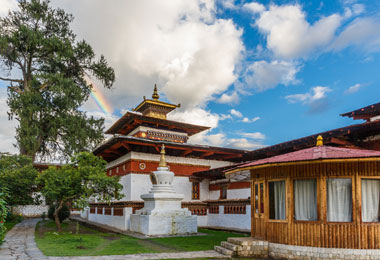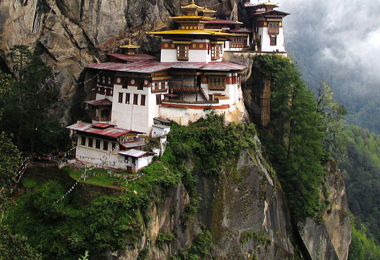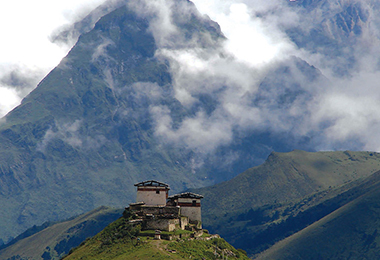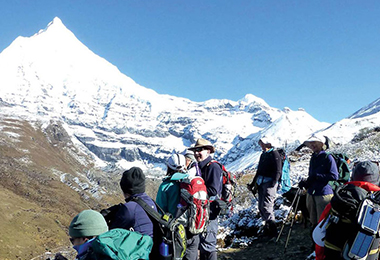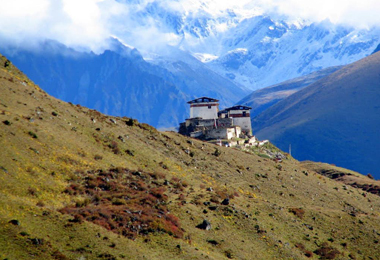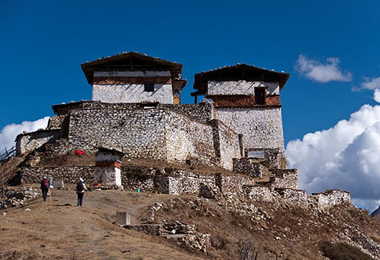
18 Days Jomolhari Laya Gasa Trek
(BTT008) Paro - Gunitsawa Village - Sharna Zampa - Thangthangkha - Jangothang - Lingshi - Chebisa - Shomuthang - Robluthang - Limithang - Laya - Koina - Gasa - Thimphu - Paro
-
Tour Type:
Escorted by private guide and vehicle; leave 365 days a year!
-
Trip Level:
Easy - suitable for all levels of fitness, family with kids and senior groups.
-
Trip Level Guide:
- Easy - suitable for all level of fitness, family with kids and senior groups.
- Moderate - suitable for ones with average level fitness, family with kids bigger than 12 yrs.
- Moderate to Strenous - suitable for ones physically fit; have experiences of high altitude trek.
- Strenuous: suitable for adventures and individual with physically fit and healthy.
-
Season:春
Spring夏
Summer秋
Autumn冬
Winter
Overview
The Laya Gasa Trek is one of the most scenic long-distance treks in Bhutan, offering amazing views of some of the most astonishing terrain and landscape of Bhutan. The trek begins from Gunitsawa village in the northern end of Paro valley, and will take you through gorgeous alpine meadows, high mountain passes, and dense forests.
The first four days of the trek follow the same route of Jomolhari Loop trek, and the trails will take you to see some of the awe-inspiring Himalayan mountain peaks like Mt. Jomolhari, Jichu Drake and Tsherimgang. After enjoying a rest day at Jangothang, you will follow the diverging path to Lingshi and all the way to Gasa. Along the way, you will travel through remote semi-nomadic villages, spot some of the high-altitude animals like blue sheep and Takin. Upon your arrival. You can also enjoy a relaxing hot spring there for rejuvenation.
This is one of the medium-hard treks offered in Bhutan owing to the high altitude and steep ascents and descents along the trail. The best season for the Jomolhari Laya Gasa Trek is April to June and September to November.
At a Glance
Day 1Paro Arrival (2,200 m)
Day 2Paro (2,200 m) - Gunitsawa Village (2,930 m)
Day 3Gunitsawa Village (2,930 m) - Sharna Zampa (2,890 m)
Day 4Sharna Zampa (2,890 m) - Thangthangkha (3,575 m)
Day 5Thangthangkha (3,575 m) - Jangothang (4,044 m)
Day 6Jangothang Halt (4,044 m)
Day 7Jangothang (4,044 m) - Lingshi (3,880 m)
Day 8Lingshi (3,880 m) - Chebisa (4,220 m)
Day 9Chebisa (4,220 m ) - Shomuthang (4,160 m)
Day 10Shomuthang (4,160 m) - Robluthang (4,140 m)
Day 11Robluthang (4,140 m) - Limithang (4,140 m)
Day 12Limithang (4,140 m) - Laya (3,840 m)
Day 13Rest / Acclimatization day in Laya (3,840 m)
Day 14Laya (3,840 m) – Koina (3,050 m)
Day 15Konia (3,050 m) to Gasa (2,340 m)
Day 16Gasa to Thimphu
Day 17Thimphu to Paro
Day 18Paro Departure
Day to Day Itinerary
Day 1: Paro Arrival (2,200 m)
Arrival by plane or driving to Paro from Phuntsholing after crossing the India-Bhutan Border. Sighting according to the arrival time.
Stay overnight in Paro hotels
Day 2: Paro (2,200 m) - Gunitsawa Village (2,930 m)
Distance: 16 km
Ascent: Ascent: 630 m
Camp Altitude: 2,890 m
Drive to Gunitsawa village from Paro. Tourist bus stops temporarily at the intermediate stations where the scenery sites locate. Morning visit of Kyichu Lhakhang, the temple built in 8th century by Tibetan king Songtsen Gampo. Climb to Taktsang Gompa known as Tiger's Nest, the most venerated and holy place in Bhutan and take an overlook of the valley from a steep cliff.
After lunch the bus will drive you to Drukyel Dzong, the place used to be the starting point of this trek. Visit the ruins of the old dzong and further ascend to military camp of Gunitsawa on the newly built road. Camp the first night just above military camp.
Camping at Gunitsawa
Day 3: Gunitsawa Village (2,930 m) - Sharna Zampa (2,890 m)
Distance: 11 km
Time: 5 h
Ascent: Descent 80 m
Camp Altitude: 2,850 m
This trek starts at Gunitsawa, a small but beautiful village not far from the army post. Before passing through this post, your trekking permit is due to be checked, so get this permit prepared (Our tour operator will help you get it ready in advance).
Camping at Sharna Zampa
Insider tips:
Have a good rest at the campsite on the opposite side of the river not far from Gunitsawa, for tomorrow’s trek becomes physically consuming.
Day 4: Sharna Zampa (2,890 m) - Thangthangkha (3,575 m)
Distance: 22 km
Time: 7-8 hours
Ascent: Ascent 685 m, descent 10 m
Camp Altitude: 3,610 m
Flanked by lush conifers and rhododendrons, the river Paro Chuu points you the way you are about to explore. Heading northwardly, you arrive at Shing Karap, a characteristic stone house at the elevation of 3,110 m after you passing through Jigme Dorji National Park, which is symbolized by a remnants of an old bridge with a house and a chorten.
Then continue to follow the trail to reach Tremo La (4,380 m), where the trail bifurcates. Don’t choose the left one, since it is an ancient trail leading to Tremo La, the old trade route from Phari Dzong in Tibet.
The stone-paved trail stretches with moderate ups and downs through dense forests of birch and fir flowed by blue pines, and eventually arrives at a meadow where our campsite is set up. Standing on the campsite, you can have a fantastic panoramic view of Jomolhari Mountain looming in front of your eyes.
Camping at Thangthangkha
Day 5: Thangthangkha (3,575 m) - Jangothang (4,044 m)
Distance: 19 km
Time: 5-6 hours
Ascent: Ascent 480 m
Camp Altitude: 4,080 m
If you miss the sunset of Mt. Jomolhari, then don’t let slip the spectacular sunrise of the mountain in the early morning. Get fully packed and continue to follow the trail along the Paro Chhu to get today’s trekking started. You will cross an army checkpoint where rough stone barracks are set up. Today, you still have the chance to enjoy a spectacular view of mountain ridges and snow-capped peaks.
The ascending trail brings you to the village of Soe after passing through the larch covered hillside. Then the view has suddenly changed, and the scenery of locals herding yaks pops into your eyes. If you are worried about having not met any highland hamlet along the route, then a cluster of stone houses on a plateau at 3,940 m will soon bump into your eyes after a one-hour trek to Takethang.
Dangochang is another village you are bound to cross before your final arrival at Janothang Base Camp. Villagers here are lived by yaks and sheep they raise and vegetables like potato, turnip, and radish they grow. Don’t miss the chance to experience the primitive life with the locals here.
The Trail goes upwardly to reach Jangothang at the altitude of 4,080 m, where a fantastic campsite can be found and a view of majestic Jomolhari is near at hand.
Camping at Jangothang Base Camp
Insider tips:
As the elevation of the trekking trail goes higher in this day, you need to slow down your hiking steps accordingly, since today’s trek will ascend to the places that can cause altitude sickness.
Day 6: Jangothang Halt (4,044 m)
The rest day or we call it the exploration day in Jangothang provides all possibilities for visitors to arrange a day hike to a nearby campsite. It is also regarded as the best day for acclimation if you plan an ascent to a higher place in Lingzhi.
There are four major trails you are recommended to take for further exploration from Jangothang. The first and the best route comes to a four-hour excursion up to the north of the camp, where after one hour’s walk you can get a splendid view of Jichu Drakye. The second option is to choose Mount Jomolhari which lies directly to the west. Or you can also ascend the numerous unclimbed mountains to the east.
Besides the listed excursion trails, here has another option waiting to be picked up. You can take an expedition to Tshophu, an eminent trout-filled lake located along the route of Jomolhari Loop Itinerary. It only takes one and a half hours to reach there.
Camping at Jangothang Base Camp
Day 7: Jangothang (4,044 m) - Lingshi (3,880 m)
Distance: 18 km
Time: 6-7 hours
Ascent: Ascent 840 m, descent 870 m
Camp Altitude: 4,010 m
This is one of the longest days of the trek. A short distance from the camp the trail begins climbing rapidly for about half an hour and then becomes a gradual ascent to the Nyilila pass at 4,870m. While on the climb enjoy the surroundings. You might see herds of blue sheep grazing on the slopes of the mountains. From the pass you will have spectacular views of Mt. Jomolhari, Jichu Drake and Tsherimgang, all of them rising above 7,000m.
It's a gradual descent to the camp where you will pass by some of the yak herder’s tents, made from yak wool. The herders use these tents while travelling to various pastures for their yaks. As you come down into the Lingshi basin, a beautiful U-shaped valley, you get a wonderful view of Lingshi Dzong on clear days. Tserimgang and its glaciers rise up at the north end of the valley. The campsite is next to a stone hut you reach just before Lingshi Dzong.
Day 8: Lingshi (3,880 m) - Chebisa (4,220 m)
Distance: 10 km
Time: 5-6 hours
Ascent: Ascent 280 m, descent 410 m
Camp Altitude: 3,880 m
10 km stretch from Lingshi to Chebisa must be the shortest trek along the entire route, and you can take it easy. Leaving Lingshi in the morning, you will soon find a chorten below Lingshi Dzong, where appears an alternative route. You can choose to stay at the uphill main route or just take a descent tour by following this route to overlap the Jomolhari Trek which has been totally deviated from the set direction of this trek.
Make an ascent to reach Lingshi Dzong (4,220 m). This Dzong was once reconstructed after the earthquake happened in 2011 and damaged its central building. In addition to a very special atmosphere of mystic tranquility, Lingshi Dzong provides a great view over the valley.
In Goyul, stone houses can be found clustering together, forming a small village unlike any other in the outbound near Bhutan cities and towns. Leaving Goyul, you soon reach the campsite at Chebisa, the valley with some houses scattering around. You can have an early rest, or you can choose to pay a visit to these primitive house you like. Besides, don’t miss the fascinating waterfall behind the village.
Day 9: Chebisa (4,220 m ) - Shomuthang (4,160 m)
Distance: 17 km
Time: 6-7 hours
Ascent: Ascent 890 m, descent 540 m
Camp Altitude: 4,220 m
Leaving Chebisa in early morning, the trail tends to become steep. You can surprisingly find flocks of blue sheep inhabiting above the slope after you have successfully ascended up to it.
Then, when you finally reach the Gobu La Pass at 4,440 m, take a look around and you may be astonished by the sceneries as well as a few of highland shepherds herding their sheep on some lower green grass paved meadows.
After Gobu La (4,410 m), you come across some ups and downs to reach Shakshepasa (3,980 m), a large U-shaped valley with a helipad site marked by a big “H”. Follow the uphill trail stretching from here to arrive at the campsite at Shomuthang.
Insider tips:
Keep your eyes trained on wildness since animals like blue sheep, bearded vultures and Himalaya griffons appear along this route.
Day 10: Shomuthang (4,160 m) - Robluthang (4,140 m)
Distance: 18 km
Time: 6-7 hours
Ascent: Ascent 700 m, descent 760 m
Camp Altitude: 4,160 m
You begin by climbing up the valley to view Kang Bum (6,526 m), the snow peak visible along the route. Then the trail keep rising, leading you to reach Jhari La, the pass at 4,750 m and two hours trek from the campsite. The snowcapped Gangchhenta (6,840 m), better known as the Great Tiger Mountain, is visible in the north.
Tsheri Jathang, the camp by the river, has become a habitat for a large number of migrated takin, the Bhutanese national animal, from summer to late autumn. The valley has been declared a takin sanctuary, so with the agreement of the herders not grazing their animals while takin inhabit here, this easily disturbed animal can find enough good in this fertile grassland.
The trail makes a steep climb upwardly and traverses into a side valley named Robluthang, where you can set your camp here.
Day 11: Robluthang (4,140 m) - Limithang (4,140 m)
Distance: 19 km
Time: 6-7 hours
Ascent: Ascent 850 descent 870 m
Camp Altitude: 4,140 m
Today’s trek tends to be a little strenuous with an initial ascent to a large glacial side valley. Then you reach Sinche La (5,005 m), the final and highest pass on the trek, before passing a moraine and a great number of marmot holes.
As you take a downhill trail, you will then meet an impressive and stunning terminal moraine and a glacial lake at the foot of the valley. You can see the classic lateral moraines where the glacier has pushed rocks up on both sides of the valley.
Below the moraine, you will cross the Kango Chhu and pass through a cedar forest interspersed with meadows to Limithang (4,140 m). Camp at this fantastic site by the river and with the snowcapped peak of Gangchhenta towering over it.
Day 12: Limithang (4,140 m) - Laya (3,840 m)
Distance: 10 km
Time: 4-5 hours
Ascent: Ascent 60 m, descent 340 m
Camp Altitude: 3,840 m
Today, you walk downhill all the way along a narrow, winding river valley. After a long time, the trail takes you through a densely forested region. The trail leads you to the west side of Laya village. From the west of the village you will have spectacular views of Mt. Gangchhenta and Mt. Masagang. In the village centre is a community school and a basic health unit with a telephone connection.
Today’s trek starts with a 20 mins downhill walk along a narrow and winding river valley to a deep cedar forests. Passing the densely forested region along the route, you reach at the Laya (3,840 m) after you passing a ridge and some stone houses.
Masang Gang (7,165 m) stands solemnly to the west far from Gangchhenta valley and you can just cease your trekking steps and camp here for a good rest and the stunning views.
Insider tips:
Along this route, you will experience a long walk through the heavily wooded and uninhabited valley. When you reach the campsite in Laya, a community school and an archery field can be found. A basic health unit centers in the village and the telephone communication is available.
Day 13: Rest / Acclimatization day in Laya (3,840 m)
The day you spend at Laya is not just taken as a recovery from the strenuous trekking far from Paro Valley, moreover, it serves as an ideal place for altitude acclimatization. Just relax and enjoy the beautiful views as far as eye can see and the remarkable inhabitants living here.
If you embark on the trek from Gasa (Punakha), you should also trek up to Laya to acclimatize and get prepared for the rest of the challenge.
Day 14: Laya (3,840 m) – Koina (3,050 m)
Distance: 19 km
Time: 6-7 hours
Ascent: Ascent 260 m, descent 1,070 m
Camp Altitude: 3,050 m
The trails wind up and down the river valley of Mo Chhu, and then reach Koina Laptsa (3300m). It offers breath-taking views of the raging river, feeder streams and waterfalls on the way. Then from the pass the trek drops down to the large stream of Koina Chhu and reach your campsite at Koina.
Day 15: Konia (3,050 m) to Gasa (2,340 m)
Distance: 14 km
Time: 6-7 hours
Ascent: Ascent 740 m, descent 1,500 m
Camp Altitude: 2,340 m
Today, you will have the last climb of the Laya Gasa Trek. You will cross Barila Pass (3900m) while pass through deep forest of fir, juniper and rhododendron. Then take the descent all the way to Gasa village at 2,770 m. You can make a short visit to the Gasa Dzong, popularly known as Trashi Thongmoen Dzong. The dzong serves as the administration center for the local people of Gasa and monastic center for the monk body. After that, drive down to the popular Gasa Hot Spring, one of the most popular hot springs in Bhutan. You can relax in the rejuvenating mineral waters there.
Day 16: Gasa to Thimphu
After breakfast, we will drive to Punakha. In Punakha, you will visit the historical Punakha Dzong, which is widely believed to be the most beautiful Bhutanese Dzong, built at the confluence of Pho Chhu and Mo Chhu Rivers. Never miss the Punakha festival around mid-Feb if you come at the right time. You will also visit Chimi Lhakhang, a popular Buddhist monastery built around 1499 by Ngawang Chogyal.
After that, we will further drive to Thimphu. On the way, we will stop at scenic Dochu La Pass (3,100m) and have a refreshment there. The perfect vintage point brings you the unobstructed vista of Great Himalayas.
Stay overnight in Thimphu.
Day 17: Thimphu to Paro
You will first enjoy a half-day sightseeing in the capital city of Thimphu, by visiting its landmarks including National Memorial Chorten, Giant Buddha Statue, Changangkha Lhakhang and traditional paper factory.
After lunch, we will depart to Paro. The drive will take about 1 hour for around 55 km.
Stay overnight in Paro.
Day 18: Paro Departure
Today, our tour guide will transfer you to Paro International Airport for your next destination. Tour service end.
Service Guide
Service Included:
- A minimum of 3 star accommodation (4 & 5 star may require an premium payment);
- All meals specified in the itinerary;
- Airport transfer, private transport for sightseeing in Bhutan;
- Experienced driver;
- An English-speaking and licensed Bhutanese tour guide for the extent of your stay;
- Entry fee and road permits;
- Government fee, royalty, taxes;
- Bottled mineral water throughout the journey.
Service Excluded:
- Bhutan Visa Fee;
- International flight to and out of Bhutan;
- Personal expenses such as drinks, postage, and laundry, etc.;
- Travel insurance in Bhutan;
- Emergency evacuation;
- Tips and gratuities;
- Costs arising from unforeseen events;
- Extra activities like cultural show, kayaking, etc.
Contact us for your dream trip now !
Enquire NowYou May Also Like
-
 3 Days Classic Bumthang Culture Trek
3 Days Classic Bumthang Culture TrekToktu Zampa - Ngang Lhakhang - Tahung - Mesithang
-
 3 Days Bumthang Owl Trek
3 Days Bumthang Owl TrekMenchugang - Dhur Village - Drangela Pass - Tharpaling Goemba
-
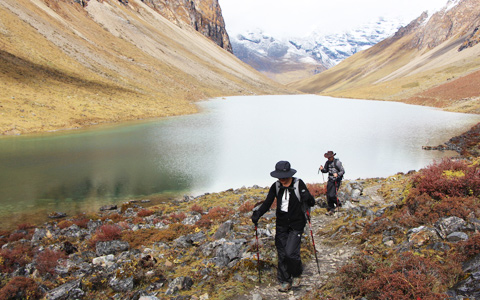 6 Days Dagala Thousand Lakes Small Group Trek
6 Days Dagala Thousand Lakes Small Group TrekGeynizampa - Gur - Labatamba - Panka - Talakha - Chamgang
-
 6 Days Most Popular Druk Path Trek in Bhutan
6 Days Most Popular Druk Path Trek in BhutanParo - Jili Dzong - Jangchhu Lakha - Jimilang Tsho - Simkotra Tsho - Phajoding - Motithang

The Laya Gasa Trek is one among the most popular trek in Bhutan, and will take you to see some of the most pristine and untouched landscapes in Bhutan.
Tibetan Travel Guru,Kham Sang
Get A Quotation of this Tour
Get Started - 18 Days Jomolhari Laya Gasa Trek
You’re getting closer to your dream Tibet vacation! Fill out this form so our travel designers can start helping you plan a trip.
Privacy Policy: Your information is kept strictly confidential. Tibet Vista will never sell, trade, or give away your contact information to a third party.

.jpg)


